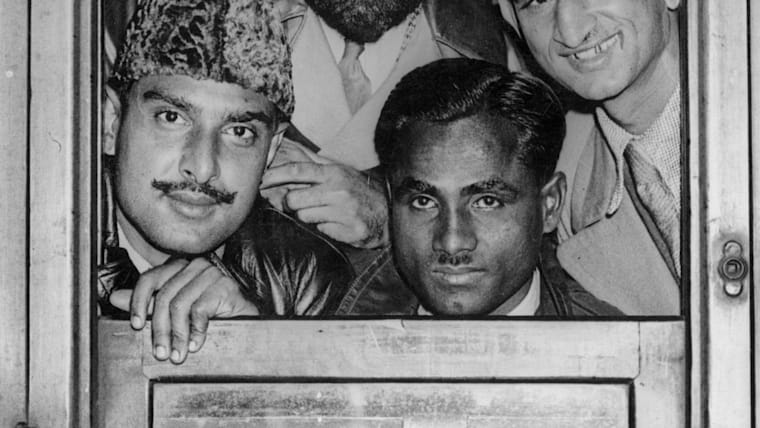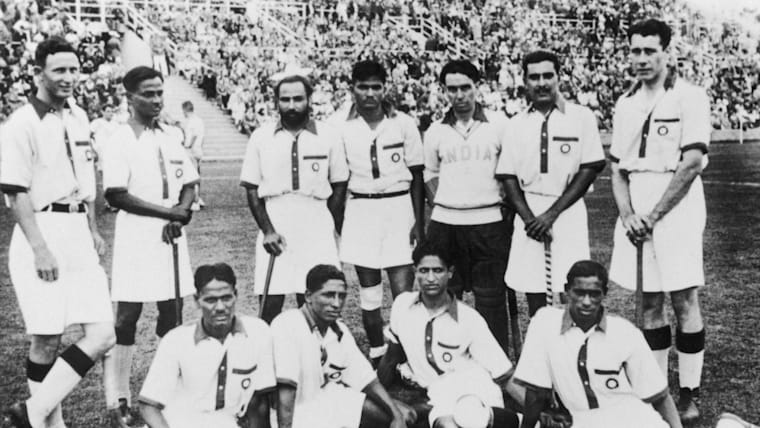News for 08 January 2021
All the news for Friday 8 January 2021
Hopes rest on Tengku
By Jugjet Singh
Tengku Ahmad Tajuddin Tengku Abdul Jalil (right) played a vital role in Universiti Kuala Lumpur’s success last year.
If Universiti Kuala Lumpur (UniKL) successfully defend their Malaysia Hockey League (MHL) treble this season, Tengku Ahmad Tajuddin Tengku Abdul Jalil will surely be the man behind it.
With no foreign players to bank on, UniKL and the other seven teams cannot afford a hiccup in the one-round competition, which starts on Jan 14.
UniKL will open their campaign in the Charity Shield against Tenaga Nasional. The university side are also the defending league and TNB Cup champions.
"We will depend on our youth players this season as we could not hire imports due to the Covid-19 pandemic.
"I want to see the juniors move the team in the direction it needs to ensure success.
"We still have the time to play some friendly matches to foster a better understanding ahead of the Charity Shield," said the 35-year-old Tengku.
It is not too much to say that he is one of the best comeback stories in Malaysian sports.
Tengku, a seasoned national player, made a super return just days after sustaining a fractured jaw last season, although he was told to rest, by leading his side to victories.
He played the remaining matches last year with a headgear designed for rugby players.
Among the newcomers are goalkeeper Shafie Sahrom, midfielder Pavandip Singh and forward Nur Rahul Hrisikesa.
Tengku also stressed that there would be no competitive imbalance in the league as all teams would not have foreign players.
"There are no small teams in the league. I have great respect for our opponents.
"For UniKL, it is going to be another great opportunity for us to show what we can do.
"We have to win all our matches to stay on top," he added.
The other teams fighting for honours are Terengganu Hockey Team, Maybank, TNB Thunderbolts, NurInsafi, UiTM HA and Sabah.
New Straits Times
Nancy Stevens Selected as 2021 NCAA Pat Summitt Award Recipient
Content Courtesy of UConn Athletics
Nancy Stevens, former head coach of the UConn field hockey program, has been selected as the recipient of the 2021 NCAA President's Pat Summitt Award. Stevens retired in September as the winningest coach in NCAA field hockey history.
Established in 2017, the Summitt Award recognizes an individual in the Association's membership who has demonstrated devotion to the development of student-athletes and has made a positive impact on their lives.
Stevens described her selection as the 2021 Summit Award recipient as a "humbling experience and an incredible honor." Stevens will be celebrated during the 2021 NCAA Convention.
"Nancy Stevens' holistic understanding of the power that sport plays in the lives of student-athletes is testament not only to her success as a coach on the field, but also as a mentor off the field," NCAA President Mark Emmert said. "Her commitment to empowering young women to excel in sport, academics and professional careers has left an immediate and lasting impact in collegiate athletics."
Stevens began her 43-year, 700-win coaching career with Penn State as an assistant coach for its field hockey and lacrosse programs. After two years with Penn State, Stevens spent the next decade of her career leading the field hockey programs at Franklin & Marshall and Northwestern.
Stevens took the head coaching position at UConn in 1990. Throughout 30 seasons, she led the Huskies to three national championships (2013, 2014 and 2017) and more than 20 NCAA tournament appearances. In addition to winning 19 Big East tournament titles and 19 Big East regular-season titles, the Huskies also produced 50 first-team All-Americans under Stevens' tutelage.
"My whole career, my focus has been encouraging young women to develop leadership skills and understand the value and benefit of teamwork," Stevens said. "It is a great privilege to work with this age group, with 18- to 21-year-old women."
Stevens attributes her program's success in using sport as a transformational experience for student-athletes, empowering players to go forward after their college careers to do great things. Her former players have had successful careers as educators, businesswomen, attorneys, orthopedic surgeons, Olympians, World Cup field hockey players and more.
"Championships are great to win, especially national championships," Stevens said. "However, I think that when you win championships together, you will walk through life together as champions. That is empowering. It fills you with the confidence to accomplish almost anything.
"As a coach, what you're doing is empowering young women to succeed. That's our program's strength and purpose, and field hockey is just a piece of that. If you can do your best to make sport a transformational experience for the players and coaches and still win national championships, I think that's where the magic lies."
Stevens previously served as chair of the NCAA Division I Field Hockey Committee and was involved in the planning and operation of the first NCAA field hockey championship, which, along with cross country, kicked off the Association's championships for women.
Selected annually by the NCAA president, Summitt Award winners receive a $10,000 honorarium to donate to an organization of the honoree's choice that combats or researches neurological diseases of the brain. Having endured family loss to neurological disease, Stevens is directing her honorarium to a research fellowship at UConn Health's Department of Neurology.
USFHA media release
New umpire development pathway launched
Hockey Ireland, in partnership with the Irish Hockey Umpires Association (IHUA) and the provincial associations, have launched a new Umpire Development Pathway.
The new pathway aims to support the growth of umpiring in Ireland in an efficient and sustainable manner.
The initial focus is on growing the base of umpires through accessible step by step courses, before further developing umpires through opportunities and support at provincial, national and international levels.
The diagram below illustrates the new and improved pathway which will replace the current National Umpire Awards Course. In its new format, the umpiring pathway will provide accessible practical and theory courses to the whole Hockey community. 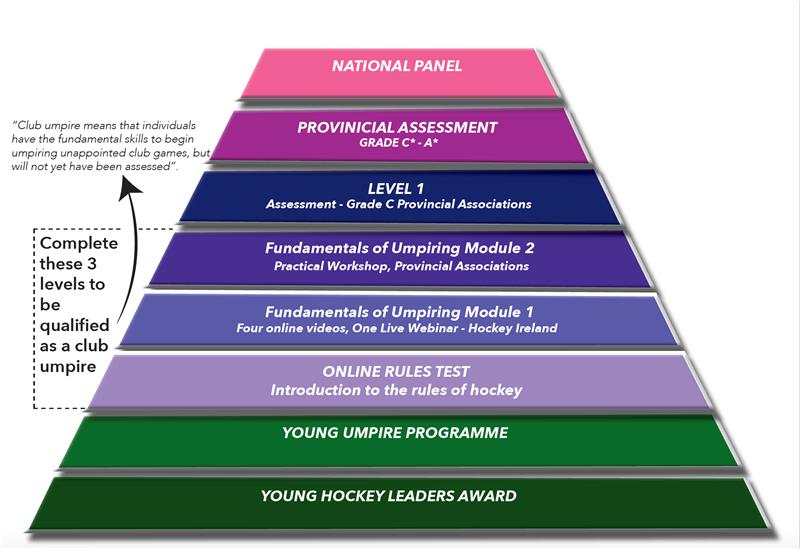
The online rules test must be completed before an individual can sign up to the Fundamentals of Umpiring module 1. Fundamentals module 1 must be completed in its entirety before signing up to Fundamentals module 2.
(Please note: The Young Hockey Leaders Award and Young Umpire Programmes are not pre-requisites for online rules.)
Once an individual has completed their online rules and Fundamentals Modules 1 and 2, they will be recognised as a club umpire (a club umpire means an individual has the skills to begin umpiring unappointed club games but will not yet have been assessed). Completing all three steps will be the equivalent to completing the National Umpire Award Course.
Commenting on the pathway, Chair of the IHUA, Rob Argent said, ”The IHUA are delighted to support Hockey Ireland with our knowledge and expertise to offer a new and improved umpire development pathway. Club umpires are the heart and soul of hockey volunteering and we would all be stuck without them.
“This pathway will support clubs, leagues and provincial associations, as well as introduce new umpires to the first step of the ladder of what we hope will be an enjoyable and successful umpiring career.”
Hockey Ireland CEO Jerome Pels said, “The new umpiring pathway offers hockey a huge opportunity to progress and grow.
“We are aware that varying standards andnumbers of umpires is a current weakness in our structure, and the new pathway will offer members and clubs support in their journey to becoming an umpire.”’
The first part of the course, the Fundamentals of Umpiring, will be launched on 12th January.
The Hook
Mariette Verstappen on the arrival of British star Lily Owsley
With the recruitment of British international and Olympic champion Lily Owsley (26) , hdm – after having already captured the American Ashley Hoffman and the British hockey players Flora Peel and Erica Sanders in recent seasons – is once again bringing in a player from abroad. However, that is not at the expense of their own youth, says Mariette Verstappen, committee member Tophockey Dames at hdm.
To start, explain why you attracted Lily Owsley.
Verstappen:'Lily was a great opportunity for us. We came into contact with her through our player Flora Peel, a good friend of hers. She had indicated that she would like to play in the Dutch league. Last season we were already talking to Lily, but then the Olympics were postponed by a year and she indicated that she would stay in England. We are happy that we have now managed to sign her for next season. She is one of the best players in the England team. She is attackingly strong, has a lot of experience and an enormous drive. Moreover, she has a click with the group; she’s already met the girls.'
We want to show our talents that you don’t have to move to another club to play play-offs.
In recent years, several talents have left hdm and made the step to the top three . With the arrival of Owsley, are you trying to ensure that the current crop of talents – including Orange potentials Tessa Clasener, Margot van Hecking Colebrander and Jong Oranje player Imme van Es – stay with HDM longer?
‘Exactly. With the arrival of Lily, we are strengthening the selection and we hope to structurally connect with the top four. In this way we hope to further train our talents and retain them for longer. This not only applies to the girls who are already playing in Ladies 1, but also to the talents who are coming. We want to show them that you don’t have to go to another club to play play-offs.'
Does the arrival of Owsley not also benefit their own youth?
‘No. Our goal is that every year two or three players from their own youth move on to Ladies 1. That was already the case and it will remain so. Our own youth is an important cornerstone of HDM, where we continue to invest time and energy. So we are certainly not going to buy a whole team together. But we do invest in targeted reinforcements. At Heren 1, we brought in a number of important players with Boris Burkhardt, Wiegert Schut (both Amsterdam) and Jasper Siebert (Cartouche) last year with the aim of promoting back to the big league as soon as possible. If that succeeds, the result is that talents from our youth will not have to transfer to another club in a few years. We also apply the same policy to women.'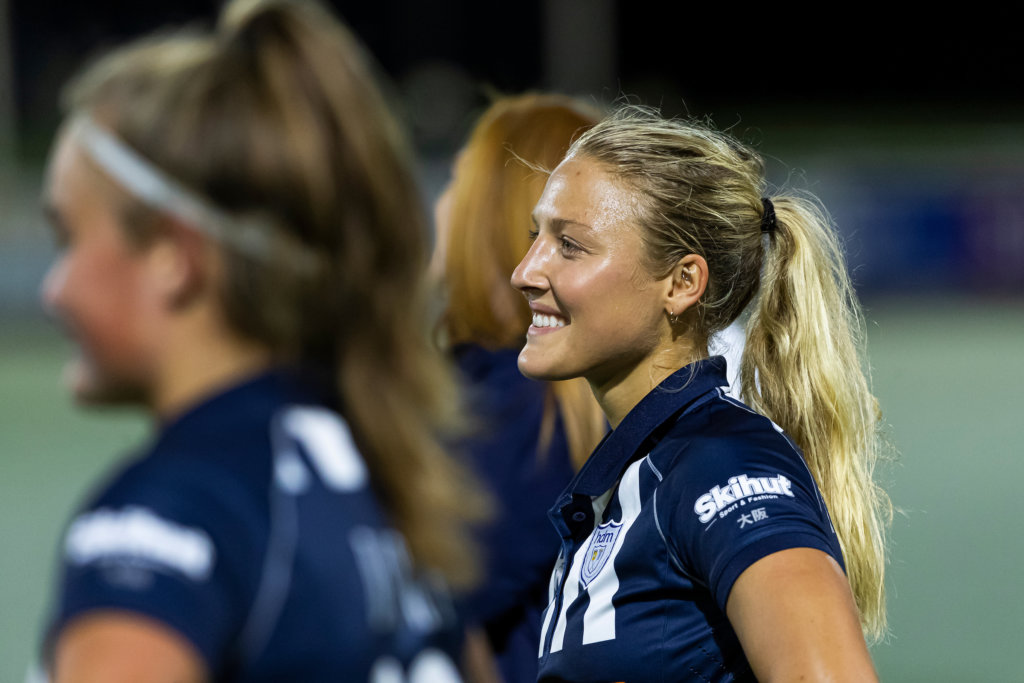
United States captain Ashley Hoffman has been playing for hdm since this season. Photo: Willem Vernes
With Ashley Hoffman, Flora Peel and Erica Sanders, the counter this season is three foreign players. If their presence and next season that of Owsley is not at the expense of their own youth, who will it be at the expense of? After all, they take four places in the match selection.
‘First of all, we are still talking with those three players about a contract for next year. The team has indicated that they prefer to stay together as much as possible, because they are now third and the atmosphere is good. So we intend to continue with them. But even with them, the selection now consists of seventy percent players from their own youth and thirty percent players from outside. We want to keep that relationship that way. In that respect, we must therefore continue to select from that group of thirty percent.
What do you think of the criticism that your own youth is not your own youth, but has been plucked away from other clubs?
‘Of the seventy percent that I mean with their own youth, three players have currently started with our minis. They are Eva't Hoog, Pien van der Heide and Willemijn Muntinga. Indeed, others later switched to us. Some did this at an early age because they wanted to develop further and therefore took the initiative themselves. There are also players who at the age of fourteen already played in Ladies 1 of Ring Pass, for example, had the ambition to play the big league and therefore came to us in the A’s. But the clubs where they started are all clubs that do not play big league themselves. I think that is an essential difference.'
Hockey World News
A Dutchman in India:'Beautiful country that requires a lot of energy’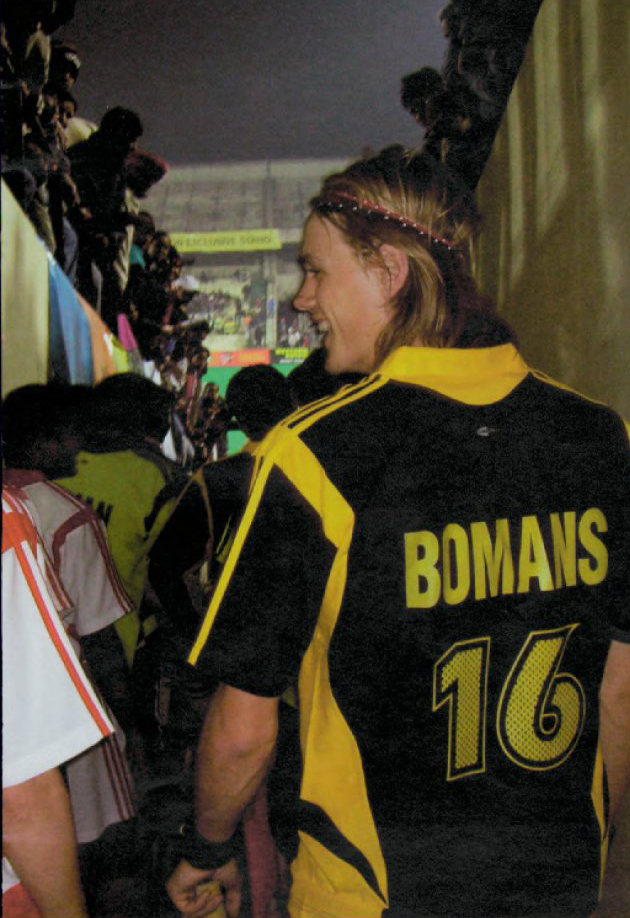
Balder Bomans in the shirt of Chandigarh Dynamos in the players tunnel on his way to the field. Photo: Hockey Magazine
In the series'Foreign adventure’ stories of Dutch hockey players who play or have played abroad, this week Balder Bomans (37). He played in the Premier Hockey League for two seasons. In his first year he reached the final with Chandigarh Dynamos, losing to the Bangalore Lions after a best-of-three.
In the middle of the night at half past one with a suitcase and a hockey stick in hand, Balder Bomans was at New Delhi airport. He looked around and took in the surroundings. It was swarming with people in a way similar to an anthill. Bomans was looking for the taxi that had been arranged for him by the organization of the Premier Hockey League (PHL) and that would bring Bomans to his hotel.
Looking for a taxi
‘I walked around for an hour in a swirling environment,’ says Bomans.'I never found the taxi. It was the middle of the night so I ended up catching another taxi, but it took me to another hotel. That taxi driver probably had a deal with that hotel, not unknown in beautiful India. A day later I still arrived at the right hotel, but like much in India it was a chaotic start.'
At the time, the 23-year-old economics student and player from Amsterdam was on his way to Chandigarh, a city some three hundred kilometers north of Delhi. The PHL was played in this place in the northeast of India. Bomans entered the top competition, which lasted a month, to play with the hosts of Chandigarh Dynamos.
Bomans was approached at the end of 2005 by Amsterdam chairman Jons Hensel and Maurits Hendriks about the Indian adventure. The idea of the PHL came from the former national coach of the Oranje Heren, who acted as an advisor to the competition. With the PHL, hockey in India had to regain popularity. Thanks to sponsorship of the TV channel ESPN, the matches could often be seen live in 43 countries.
Recognition
It delivered an audience of millions, something Bomans noticed more and more as the competition progressed.'As the tournament progressed, I became more and more recognized and had to sign autographs. No, I didn’t have that reputation in the big league, if only that was true. Haha. I could not go to the locker room without a police escort. My brother, who was there as a spectator and looks like me, could no longer move freely without guidance.'
‘There was a wave to the players’ bus and cars followed us,’ Bomans continues.'The people in India are enthusiastic. Often they just want to be on TV and jump in front of the camera. I gradually got used to it.'
The PHL consisted of five teams that played against each other in a pool system. After eight rounds, the numbers one and two of the final ranking in the pool played in a best-of-three for the title. The competition also experimented with new regulations. For example, the playing time was divided over four quarters of 17.5 minutes and free hits in the 23-meter area were no longer allowed to be pumped directly into the circle, but the ball had to roll five meters first.
Foreigners
Bomans, together with Bloemendaler Lodewijk de Bruin, who played for Martha Warriors, was the only Dutchman in the competition. In addition, two Spaniards, an Argentinian, a New Zealander and eight Pakistanis were active in the PHL.
‘At Chandigarh I was in a team full of Indians,’ says Bomans.'Both sides had to get used to that, they had to get used to me as a foreigner and I had to find my place in the team.’ The initial reluctance in the team turned into acceptance after the four-time international convinced based on his qualities. Still, it continued to adapt to training and matches for the midfielder and go along with the Indian system.
‘I am talking about 2006 now, so that is not the reality of today’, Bomans explains. “But during practice, we skipped a few balls after warming up, sometimes with a passing exercise, and then we played a game.”
Game type
In the game, everyone was running after the ball. A midfield did not exist. They attacked with five men and when they lost the ball, there were five men in the back to defend. They were good players individually, but they didn’t have the structure right for each other.'
The hockey heart of the PHL was in a beautiful mountainous environment. Chandigarh is not only more colourful but also relatively richer than other cities in India.'It is a more structured city. It has wide streets. It has an almost American set-up,'says Bomans.
‘India is a beautiful country, but requires a lot of energy,’ Bomans continues.'People live on the street. They are generally extremely hospitable and you enjoy that, but it is also a matter of paying attention, because there are many different layers in the population and the gap between rich and poor is big, and it shows.
Balder Bomans (l) and Lodewijk de Bruijn (r) in the hotel room during the Premier Hockey League in India. Photo: Hockey Magazine
Religion
Religion plays a big role in the lives of the Indians, including in the preparation for the matches. “Before every game we went to a temple. That temple was supported by the team and the manager handed over a sum of money upon entry. Then we had a ceremony from an hour to an hour and a half, we would sit on our knees and pray before the game. I said of my Dutch sobriety: explain to me, the opponent will do the same for the match. Who wins then? They hadn’t thought about that. They said: there is a god and he supports us.'
With Chandigarh Dynamos, Bomans closed the group phase as number one. Bangalore Lions was the opponent in the final. After both teams had won one game each, the decision fell in the third game.
‘There were 35,000 people in the stands,’ says Bomans.'At the start of the competition there were still a few thousand, but there were more and more. The game was halted due to fireworks bombs. It was complete chaos. Bizarre', says Bomans, who had to leave the title to the Bangalore Lions with his team.
Motivation
Although a month of hockey just did not yield a top prize, Bomans was able to credit a nice amount to his bank account.'Money was never my motivation. It was a fun combination of playing and traveling through India. For me it was more about experiencing the Indian culture and playing and experiencing sports in a different culture.'
The following year, Bomans decided to play in the PHL again, but when he looks back on that first season, Bomans says:'That first year was special. I entered it blank and had no expectations. I came across an email that I then sent to Maurits (Hendriks, ed.) With a hundred questions. Haha. But of course he didn’t know all the answers to those questions. I have gained a beautiful experience. It was insane.'
Hockey World News
Zafar Iqbal on the humility of Indian hockey wizard Dhyan Chand
The former India skipper reveals how Dhyan Chand travelled in a general compartment from Delhi to Jhansi to watch a hockey match
By Samrat Chakraborty
Dhyan Chand is regarded by many as the greatest hockey player to have ever graced the game. Known as the ‘Wizard of Hockey’, for his dribbling and ball control, he guided India to three Olympic gold medals in 1928, 1932 and 1936.
He has over 400 international goals to his name and after watching him play cricket legend Sir Don Bradman stated, "He scores goals like runs in cricket.”
But this legendary player led a very simple life until his death in 1979 at the age of 74. He joined the Indian army at 17 but due to his superlative performance on the hockey pitch during the New Zealand tour, he was promoted to the rank of Lance Naik on his return to India.
Former India skipper Zafar Iqbal had the good fortune of meeting with Chand as they used to stay at the same colony in Vasant Vihar, New Delhi. He said that the Padma Bhushan winner would always strive for excellence rather than running after money.
"He was the simplest man I would say in sporting history. He never asked for any money or boast about himself. We often chatted." - Zafar Iqbal to IANS
Dhyan Chand (standing second from left) with the Indian hockey team at the 1936 Berlin Olympics. Photo: Olympic Archives.
Iqbal went on to narrate an incident that would emphasize how humble and down to earth Chand was even after winning so many accolades.
"In 1978, we travelled with him from Delhi to Jhansi. Ashok (Dhyan Chand's son) was also there. We had to play a match there. We got into a third class (general compartment) and it was fully packed. There was no place to sit. Dhyan Chand, however, kept standing and didn't say anything to anyone," he revealed.
"After some time, we requested a person to offer us a place to sit. Such was his simplicity. We didn't have enough money to travel by first class. But Dhyan Chand never created any fuss."
Iqbal believes that Chand's legacy in hockey cannot be quantified.
"His contribution to the country in the field of hockey is immense and something which we are very proud of. He is recognised by his game and not by awards," he mentioned.
Olympic Channel
